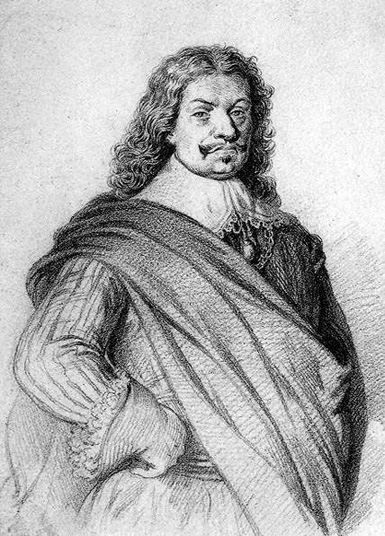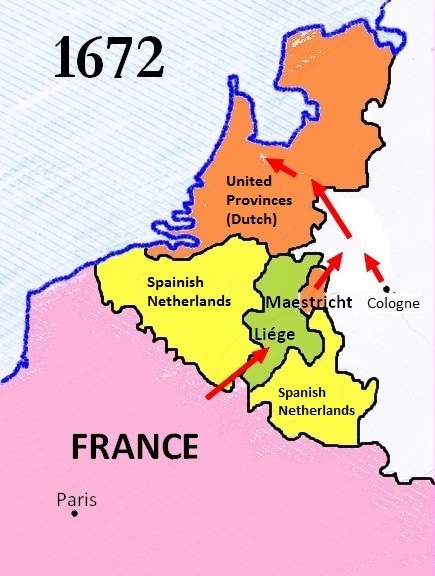|
Johann Hartmann Von Rosenbach
Johann Hartmann von Rosenbach ((Sept 15, 1609 - April 19, 1675) was the Prince-Bishop of Würzburg from 1673 to 1675. Johann Hartmann von Rosenbach was born in Stammheim, Florstadt on 15 September 1609 to Johann Dietrich von Rosenbach (major of Amoneburg and Friedburg) and his wife Susanna Regina von Knoringen, as the eldest of four children; his brother Heinrich became canon in Wurzburg and his brother Philipp headed the Fulda Monastery. Johann received minor orders in 1627 and became a judge in 1652. The cathedral chapter of Würzburg Cathedral elected him Prince-Bishop of Würzburg on 13 March 1673, with Pope Clement X confirming his appointment on 10 September 1674. He was consecrated as a bishop by Stephan Weinberger, auxiliary bishop of Würzburg on 6 January 1675. During his time as Prince-Bishop, the Franco-Dutch War spilled into the Prince-Bishopric of Würzburg, with forces under Henri de la Tour d'Auvergne, Vicomte de Turenne invading the bishopric. These fo ... [...More Info...] [...Related Items...] OR: [Wikipedia] [Google] [Baidu] |
Peter Philipp Von Dernbach
Peter Philipp von Dernbach (1619–1683) was the Prince-Bishop of Bamberg from 1672 to 1683 and Prince-Bishop of Würzburg from 1675 to 1683. Peter Philipp von Dernbach was born in Geisa on 1 July 1619. His father was a Lutheran who later converted to Roman Catholicism. He became a canon of Bamberg Cathedral on 7 February 1631, and a canon of Würzburg Cathedral on 25 February 1643. He spent 1642-43 studying at the University of Bamberg, and then moved on to study at the ''Collegium Germanicum'' in Rome. On 31 May 1649, he was made a prebendary of Bamberg Cathedral; he became a prebendary of Würzburg Cathedral on 7 August 1649. On 27 June 1651, he succeeded Philipp Valentin Albrecht Voit von Rieneck as provost of Bamberg Cathedral. He was appointed Bishop of Bamberg on 22 March 1672, with Pope Clement X confirming his appointment on 28 January 1675. He was ordained as a priest on 19 May 1675. He was consecrated as a bishop by Damian Hartard von der Leyen-Hohengeroldseck, A ... [...More Info...] [...Related Items...] OR: [Wikipedia] [Google] [Baidu] |
Johann Philipp Von Schönborn
Johann Philipp von Schönborn (6 August 1605 – 12 February 1673) was the Archbishop-Elector of Mainz (1647–1673), the Bishop of Würzburg (1642–1673), and the Bishop of Worms (1663–1673). Life Johann Philipp was born in his family's manor house at Laubuseschbach (present-day Hesse) to Georg von Schönborn, a minor nobleman at the employ of the Lutheran counts of Wied. The Schönborn family had knightly rank and was first mentioned in 1275. However, by the time Johann Philipp grew up, most branches of the family had extinguished, and in fact, he and his brother were the last sprouts of the family. Laubuseschbach, Schönbornscher Hof.JPG, Birth house in Laubuseschbach In 1621, after it had been ascertained that he possessed the minimum quarters of nobility required, he was admitted as a minor canon (domizellar) by the cathedral chapter of Wurzburg Cathedral, and in 1625 by the cathedral chapter of Mainz Cathedral as well. In 1626, he received consecrati ... [...More Info...] [...Related Items...] OR: [Wikipedia] [Google] [Baidu] |
Raimondo Montecuccoli
Raimondo Montecuccoli (; 21 February 1609 – 16 October 1680) was an Italian-born professional soldier, military theorist, and diplomat, who served the Habsburg monarchy. Experiencing the Thirty Years' War from scratch as a simple footsoldier, he rose through the ranks into a regiment holder and became an important cavalry commander in the late stages. Serving the Habsburgs as war counsellor and envoy, he commanded their troops in the Second Northern War and the Austro-Turkish War of 1663–64 where he scored an impressive victory in the Battle of Saint Gotthard. Afterwards, he became president of the Hofkriegsrat and briefly returned as supreme commander of the Imperial forces during the Franco-Dutch War. Montecuccoli was considered the only commander able to compete with the French general Turenne, (1611–1675), and like him, was closely associated with the post-1648 development of linear infantry tactics. Early life Montecuccoli was born on 21 February 1609 in the C ... [...More Info...] [...Related Items...] OR: [Wikipedia] [Google] [Baidu] |
Henri De La Tour D'Auvergne, Vicomte De Turenne
Henri de La Tour d'Auvergne, vicomte de Turenne (11 September 161127 July 1675), commonly known as Turenne , was a French general and one of only six Marshals to have been promoted Marshal General of France. The most illustrious member of the La Tour d'Auvergne family, his military exploits over his five-decade career earned him a reputation as one of the greatest military commanders in history. Born to a Huguenot family, the son of a Marshal of France, he was introduced to the art of war at a young age. He first served as a volunteer in the Dutch States Army under the orders of his maternal uncles Maurice of Nassau and Frederick Henry but later chose to continue his career in the service of France, where his noble origins and proven qualities soon saw him rise to the top of the military hierarchy. He rose to prominence during the Thirty Years' War by capturing the fortress of Breisach in 1638. Promoted Marshal of France in 1643, he struck against Bavaria the followin ... [...More Info...] [...Related Items...] OR: [Wikipedia] [Google] [Baidu] |
Franco-Dutch War
The Franco-Dutch War, also known as the Dutch War (french: Guerre de Hollande; nl, Hollandse Oorlog), was fought between France and the Dutch Republic, supported by its allies the Holy Roman Empire, Spain, Brandenburg-Prussia and Denmark-Norway. In its early stages, France was allied with Münster and Cologne, as well as England. The 1672 to 1674 Third Anglo-Dutch War and 1675 to 1679 Scanian War are considered related conflicts. The war began in May 1672 when France nearly overran the Dutch Republic, an event still known as the '' Rampjaar'' or "Disaster Year". Their advance was halted by the Dutch Water Line in June and by late July the Dutch position had stabilised. Concern over French gains led to a formal alliance in August 1673 between the Dutch, Emperor Leopold I, Spain and Brandenburg-Prussia. They were joined by Lorraine and Denmark, while England made peace in February 1674. Now facing a war on multiple fronts, the French withdrew from the Dutch Republic, ret ... [...More Info...] [...Related Items...] OR: [Wikipedia] [Google] [Baidu] |
Bishop
A bishop is an ordained clergy member who is entrusted with a position of authority and oversight in a religious institution. In Christianity, bishops are normally responsible for the governance of dioceses. The role or office of bishop is called episcopacy. Organizationally, several Christian denominations utilize ecclesiastical structures that call for the position of bishops, while other denominations have dispensed with this office, seeing it as a symbol of power. Bishops have also exercised political authority. Traditionally, bishops claim apostolic succession, a direct historical lineage dating back to the original Twelve Apostles or Saint Paul. The bishops are by doctrine understood as those who possess the full priesthood given by Jesus Christ, and therefore may ordain other clergy, including other bishops. A person ordained as a deacon, priest (i.e. presbyter), and then bishop is understood to hold the fullness of the ministerial priesthood, given responsibil ... [...More Info...] [...Related Items...] OR: [Wikipedia] [Google] [Baidu] |
Consecrated
Consecration is the solemn dedication to a special purpose or service. The word ''consecration'' literally means "association with the sacred". Persons, places, or things can be consecrated, and the term is used in various ways by different groups. The origin of the word comes from the Latin stem ''consecrat'', which means dedicated, devoted, and sacred. A synonym for consecration is sanctification; its antonym is desecration. Buddhism Images of the Buddha and bodhisattvas are ceremonially consecrated in a broad range of Buddhist rituals that vary depending on the Buddhist traditions. Buddhābhiseka is a Pali and Sanskrit term referring to these consecration rituals. Christianity In Christianity, consecration means "setting apart" a person, as well as a building or object, for God. Among some Christian denominations there is a complementary service of "deconsecration", to remove a consecrated place of its sacred character in preparation for either demolition or sale for s ... [...More Info...] [...Related Items...] OR: [Wikipedia] [Google] [Baidu] |
Pope Clement X
Pope Clement X ( la, Clemens X; it, Clemente X; 13 July 1590 – 22 July 1676), born Emilio Bonaventura Altieri, was head of the Catholic Church and ruler of the Papal States from 29 April 1670 to his death in July 1676. Elected pope at age 79, he has since been ranked as the oldest pope at the time of his election. Early life Emilio Boneventura Altieri was born in Rome in 1590, the son of Lorenzo Altieri and Vittoria Delfin, a noble Venetian lady, sister of Flaminio Delfin, commander general of the Papal Armies, and of Gentile Delfin, Bishop of Camerino. His brother was Giambattista Altieri. The Altieri family belonged to the ancient Roman nobility and had enjoyed the highest consideration at Rome for several centuries; they had occasionally contracted alliances with the Colonnas and the Orsinis. During earlier pontificates, the Altieri held many important offices and had been entrusted with several delicate missions. Early work Altieri received a doctorate in law fr ... [...More Info...] [...Related Items...] OR: [Wikipedia] [Google] [Baidu] |





